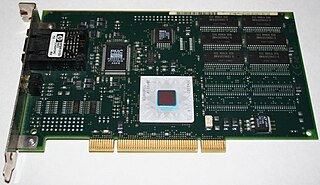Related Research Articles

Asynchronous Transfer Mode (ATM) is a telecommunications standard defined by the American National Standards Institute and ITU-T for digital transmission of multiple types of traffic. ATM was developed to meet the needs of the Broadband Integrated Services Digital Network as defined in the late 1980s, and designed to integrate telecommunication networks. It can handle both traditional high-throughput data traffic and real-time, low-latency content such as telephony (voice) and video. ATM provides functionality that uses features of circuit switching and packet switching networks by using asynchronous time-division multiplexing. ATM was seen in the 1990s as a competitor to Ethernet and networks carrying IP traffic as, unlike Ethernet, it was faster and designed with quality-of-service in mind, but it fell out of favor once Ethernet reached speeds of 1 gigabits per second.
Quality of service (QoS) is the description or measurement of the overall performance of a service, such as a telephony or computer network, or a cloud computing service, particularly the performance seen by the users of the network. To quantitatively measure quality of service, several related aspects of the network service are often considered, such as packet loss, bit rate, throughput, transmission delay, availability, jitter, etc.
Network throughput refers to the rate of message delivery over a communication channel, such as Ethernet or packet radio, in a communication network. The data that these messages contain may be delivered over physical or logical links, or through network nodes. Throughput is usually measured in bits per second, and sometimes in data packets per second or data packets per time slot.
A virtual circuit (VC) is a means of transporting data over a data network, based on packet switching and in which a connection is first established across the network between two endpoints. The network, rather than having a fixed data rate reservation per connection as in circuit switching, takes advantage of the statistical multiplexing on its transmission links, an intrinsic feature of packet switching.

The transputer is a series of pioneering microprocessors from the 1980s, intended for parallel computing. To support this, each transputer had its own integrated memory and serial communication links to exchange data with other transputers. They were designed and produced by Inmos, a semiconductor company based in Bristol, United Kingdom.

Meiko Scientific Ltd. was a British supercomputer company based in Bristol, founded by members of the design team working on the Inmos transputer microprocessor.
Wormhole flow control, also called wormhole switching or wormhole routing, is a system of simple flow control in computer networking based on known fixed links. It is a subset of flow control methods called Flit-Buffer Flow Control.
NetFlow is a feature that was introduced on Cisco routers around 1996 that provides the ability to collect IP network traffic as it enters or exits an interface. By analyzing the data provided by NetFlow, a network administrator can determine things such as the source and destination traffic, class of service, and the causes of congestion. A typical flow monitoring setup consists of three main components:

The RapidIO architecture is a high-performance packet-switched electrical connection technology. It supports messaging, read/write and cache coherency semantics. Based on industry-standard electrical specifications such as those for Ethernet, RapidIO can be used as a chip-to-chip, board-to-board, and chassis-to-chassis interconnect.
A load-balanced switch is a switch architecture which guarantees 100% throughput with no central arbitration at all, at the cost of sending each packet across the crossbar twice. Load-balanced switches are a subject of research for large routers scaled past the point of practical central arbitration.
The Intel QuickPath Interconnect (QPI) is a point-to-point processor interconnect developed by Intel which replaced the front-side bus (FSB) in Xeon, Itanium, and certain desktop platforms starting in 2008. It increased the scalability and available bandwidth. Prior to the name's announcement, Intel referred to it as Common System Interface (CSI). Earlier incarnations were known as Yet Another Protocol (YAP) and YAP+.
In telecommunications and computer networking, connection-oriented communication is a communication protocol where a communication session or a semi-permanent connection is established before any useful data can be transferred. The established connection ensures that data is delivered in the correct order to the upper communication layer. The alternative is called connectionless communication, such as the datagram mode communication used by Internet Protocol (IP) and User Datagram Protocol (UDP), where data may be delivered out of order, since different network packets are routed independently and may be delivered over different paths.
Avionics Full-Duplex Switched Ethernet (AFDX), also ARINC 664, is a data network, patented by international aircraft manufacturer Airbus, for safety-critical applications that utilizes dedicated bandwidth while providing deterministic quality of service (QoS). AFDX is a worldwide registered trademark by Airbus. The AFDX data network is based on Ethernet technology using commercial off-the-shelf (COTS) components. The AFDX data network is a specific implementation of ARINC Specification 664 Part 7, a profiled version of an IEEE 802.3 network per parts 1 & 2, which defines how commercial off-the-shelf networking components will be used for future generation Aircraft Data Networks (ADN). The six primary aspects of an AFDX data network include full duplex, redundancy, determinism, high speed performance, switched and profiled network.

IEEE Standard 1355-1995, IEC 14575, or ISO 14575 is a data communications standard for Heterogeneous Interconnect (HIC).
ARINC 818: Avionics Digital Video Bus (ADVB) is a video interface and protocol standard developed for high bandwidth, low-latency, uncompressed digital video transmission in avionics systems. The standard, which was released in January 2007, has been advanced by ARINC and the aerospace community to meet the stringent needs of high performance digital video. The specification was updated and ARINC 818-2 was released in December 2013, adding a number of new features, including link rates up to 32X fibre channel rates, channel-bonding, switching, field sequential color, bi-directional control and data-only links.
Isra Vision Parsytec AG is a company of Isra Vision, founded in 1985 as Parsytec in Aachen, Germany.
CoDel is an active queue management (AQM) algorithm in network routing, developed by Van Jacobson and Kathleen Nichols and published as RFC8289. It is designed to overcome bufferbloat in networking hardware, such as routers, by setting limits on the delay network packets experience as they pass through buffers in this equipment. CoDel aims to improve on the overall performance of the random early detection (RED) algorithm by addressing some of its fundamental misconceptions, as perceived by Jacobson, and by being easier to manage.
In computer networking, a flit is a link-level atomic piece that forms a network packet or stream. The first flit, called the header flit holds information about this packet's route and sets up the routing behavior for all subsequent flits associated with the packet. The header flit is followed by zero or more body flits, containing the actual payload of data. The final flit, called the tail flit, performs some book keeping to close the connection between the two nodes.
Time-Sensitive Networking (TSN) is a set of standards under development by the Time-Sensitive Networking task group of the IEEE 802.1 working group. The TSN task group was formed in November 2012 by renaming the existing Audio Video Bridging Task Group and continuing its work. The name changed as a result of the extension of the working area of the standardization group. The standards define mechanisms for the time-sensitive transmission of data over deterministic Ethernet networks.

A butterfly network is a technique to link multiple computers into a high-speed network. This form of multistage interconnection network topology can be used to connect different nodes in a multiprocessor system. The interconnect network for a shared memory multiprocessor system must have low latency and high bandwidth unlike other network systems, like local area networks (LANs) or internet for three reasons:
References
- Thompson, P.; Lewis, J. (1994). "The STC104 Packet Routing Chip". VLSI Design. 2 (4): 305–314. doi: 10.1155/1995/92096 .
- May, M. D.; Thompson, P.W.; Welch, P. h., eds. (1993). Networks, Routers and Transputers: Function, Performance, and Applications. INMOS Limited. IOS Press.
- Jones, N. J.; Davies, M. A.; Wright, C. J. (1997). The Network Designer's Handbook. IOS Press.
- INMOS STC104 asynchronous packet switch Engineering data (Technical report). SGS-Thompson Microelectronics. June 1996.
- Van Leeuwen, Jan; Tan, Richard B. (1987). "Interval routing". The Computer Journal. 30 (4): 298–307. doi: 10.1093/comjnl/30.4.298 .
- Valiant, Leslie G. (1982). "A scheme for fast parallel communication". SIAM Journal on Computing. 11 (2): 350–361. doi:10.1137/0211027.